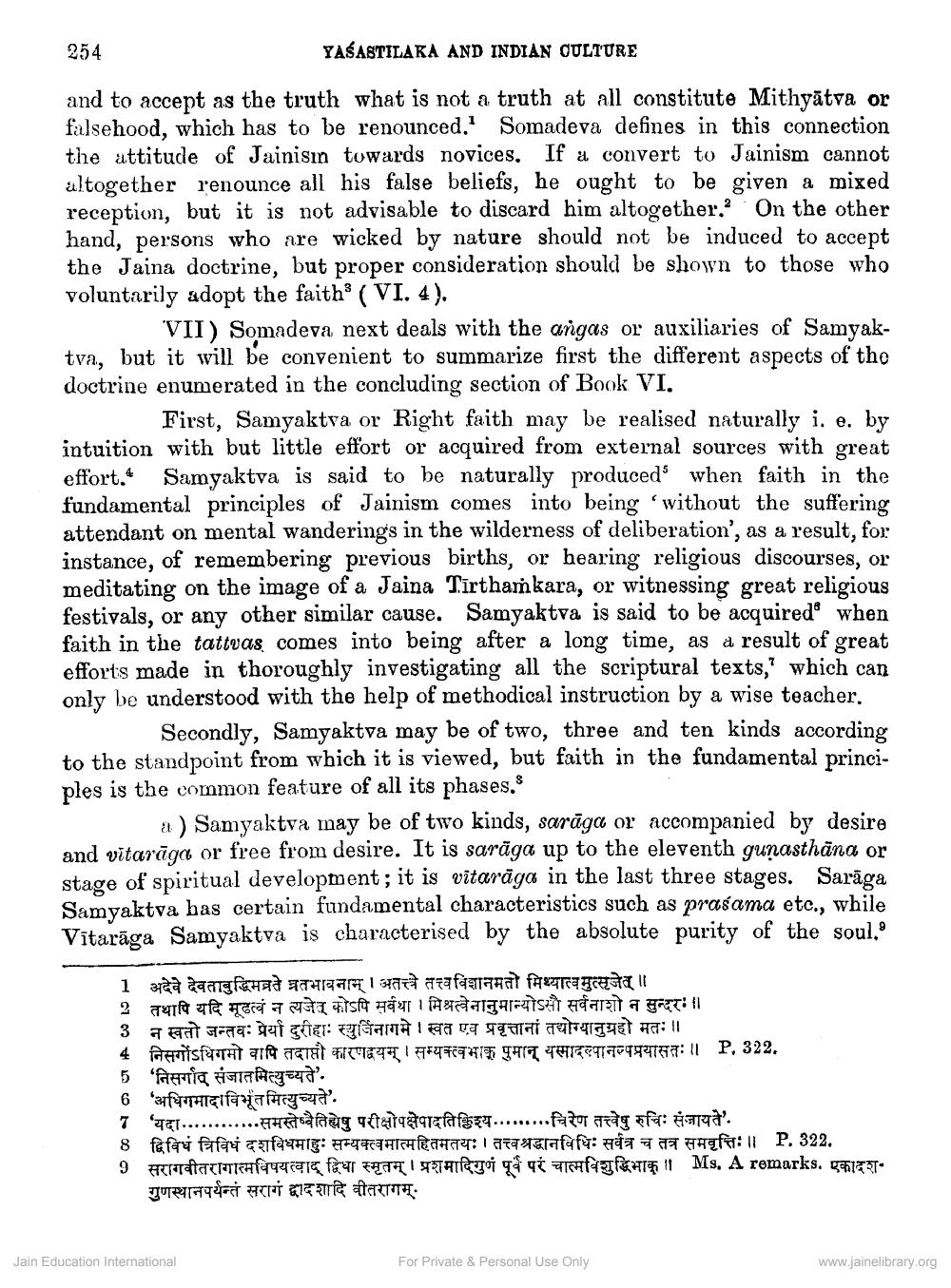________________
254
YASASTILAKA AND INDIAN CULTURE
and to accept as the truth what is not a truth at all constitute Mithyātva or falsehood, which has to be renounced. Somadeva defines in this connection the attitude of Jainisin towards novices. If a convert to Jainism cannot altogether renounce all his false beliefs, he ought to be given a mixed reception, but it is not advisable to discard him altogether. On the other hand, persons who are wicked by nature should not be induced to accept the Jaina doctrine, but proper consideration should be shown to those who voluntarily adopt the faith ( VI. 4).
'VII) Somadeva next deals with the angas or auxiliaries of Samyaktva, but it will be convenient to summarize first the different aspects of the doctrine enumerated in the concluding section of Book VI.
First, Samyaktva or Right faith may be realised naturally i. e. by intuition with but little effort or acquired from external sources with great effort. Samyaktva is said to be naturally produced when faith in the fundamental principles of Jainism comes into being 'without the suffering attendant on mental wanderings in the wilderness of deliberation', as a result, for instance, of remembering previous births, or hearing religious discourses, or meditating on the image of a Jaina Tirthamkara, or witnessing great religious festivals, or any other similar cause. Samyaktva is said to be acquired when faith in the tattvas comes into being after a long time, as a result of great efforts made in thoroughly investigating all the scriptural texts," which can only be understood with the help of methodical instruction by a wise teacher.
Secondly, Samyaktva may be of two, three and ten kinds according to the standpoint from which it is viewed, but faith in the fundamental principles is the common feature of all its phases.
a) Samyaktva may be of two kinds, sarāga or accompanied by desire and vitarāga or free from desire. It is sarāga up to the eleventh gunasthāng or stage of spiritual development; it is vitarăgo in the last three stages. Sarāga Samyaktva has certain fundamental characteristics such as prasama etc., while Vītaräga Samyaktva is characterised by the absolute purity of the soul."
1 अदेवे देवताबुद्धिमत्रते व्रतभावनाम् । अतत्वे तत्वविज्ञानमतो मिथ्यात्वमुत्सृजेत् ॥ 2 तथापि यदि मूढत्वं न त्यजेत् कोऽपि सर्वथा । मिश्रत्वेनानुमान्योऽसौ सर्वनाशो न सुन्दरः ।। 3 न स्वतो जन्तवः प्रेया दुरीहाः स्युर्जिनागमे । स्वत एव प्रवृत्तानां तद्योग्यानुग्रहो मतः।। 4 Freits THT TRATTAT FIT&TT I FF7c715 CATT TETT77999767:11 P, 322. 5 Antig HSAsud'. 6 ' Thielfajafaryzya'. 7 471............ saraag aaraa fass4.........Pazo atag sa: 4 . 8 fafau fafau cyfaqiy: HTFAHRT: 1 atasarafafy: Tahf#:11 P. 322. 9 Ferratacitiffyg calg for HTH | TAY gå at archaykha ! Ms. A remarks,
गुणस्थानपर्यन्तं सराग द्वादशादि वीतरागम्.
ZT
Jain Education International
For Private & Personal Use Only
www.jainelibrary.org




